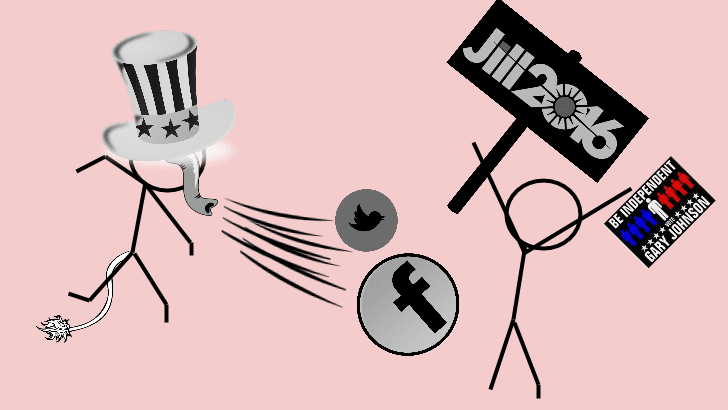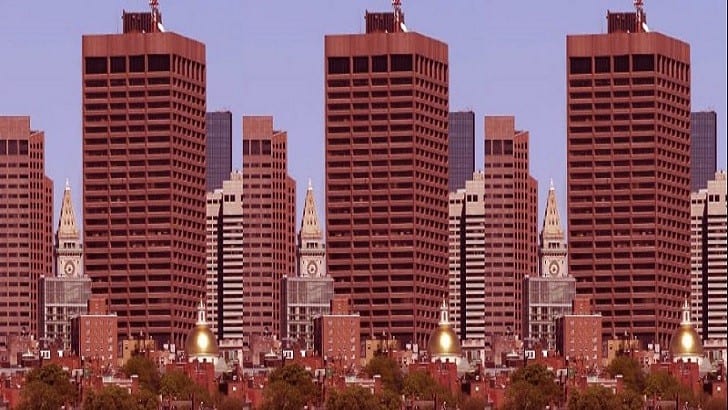
July 30, 2016
BY JASON PRAMAS @JASONPRAMAS
Blue and Red stalwarts should stop attacking minor party supporters for remaining independent—and start debating ideas
The quadrennial whinefest has already begun.
The RNC and DNC pageants are barely over, the presidential election is still over three months off, and yet major party stalwarts are already trying to police the growing margins of their parties and guilt trip them into voting against their consciences. Sadly, this behavior has become a ritual of American politics. One that needs to end if we’re ever going to have a system that offers voters more choices than “Column A or Column B.” Or, as comedian Barry Crimmins once put it: “Do you want to get hit over the head with a hammer or a mallet?”
In the last few days, I have read at least a dozen impassioned pleas from people on the broad political left in my social network begging anyone who will listen to not be “stupid” and “throw their votes away” by backing the Green Party, the Libertarian Party, or any party other than the Democrats this fall. When begging fails, they turn to hectoring—usually based on the Reductio ad Hitlerum fallacy: 2016 is 1933. Trump is Hitler. If you don’t vote Democrat, you’re letting the Nazis win.
When hectoring tanks, they start the insults. Which soon devolve into digital shouting matches. Convincing no one who wasn’t already convinced. But solidifying their belief that they’re the only ones possessing the relevant facts and the “maturity” to take “rational” action. That their political equation is the only political equation. That their choice is the only “sane” one. But that’s incorrect.
People can share some of the Democrats’ stated “progressive” views and still vote for minor party candidates, or for Trump, or for “None of the Above”—an option that many Americans choose on a regular basis. Because they understand that, in practice, Democratic presidents often back reactionary policies in the interest of multinational corporations and the rich. And they prefer to vote for the best candidate possible, or simply lodge a protest vote. Which they have every right to do.
I’ve also seen similar arguments being made from the political right—if not as vociferously—mostly concerned about the Libertarian Party “stealing” votes from Republicans. (Although, at the moment, it’s looking like Libertarians will woo voters away from both the Democrats and the Republicans. Providing the potential for umbrage from Hillary Clinton and Donald Trump supporters alike, one supposes).
So just a reminder to all major party supporters—including the Boston Globe’s Yvonne Abraham, whose hatchet job on Green Party presidential candidate Jill Stein this week is a textbook example of the behavior in question: people in minor political parties are not in your political parties. They are Greens. They are Libertarians. They are Socialist Party (yes, they’re running national candidates, too), et cetera. And while they certainly have to figure out their relationship to other parties as part of their political strategy, they are not required to do what you want them to do. They are also not “idiots” for hewing to their own political course. Or for failing to fall into line behind the current duopoly.
Even though so-called “third” parties haven’t had a chance at winning major national elections for a longlong time, and even though we don’t have a parliamentary system in the US, that doesn’t mean their efforts are wasted. Or that their votes are “thrown away.”
Small parties run national elections for any number of reasons, but two big ones are to qualify for federal election funding and to earn a slot in the presidential debates. Others include: support for lower level candidates, demonstrating that their party has a national presence, the possibility of forcing one of the major parties to cut a deal on a key policy issue, and gaining visibility for their ideas. Whatever the reason, they are not stealing votes from anybody. They are vying for constituencies like any other party and trying to win them over and gain their support.
That’s politics, folks. It’s real life. The more power that’s at stake, the uglier it gets. As we just saw (and perhaps are still seeing courtesy of Wikileaks) with the highly questionable Clinton victory over Bernie Sanders in the race for the Democratic nomination.
Therefore I suggest that major party backers remember that fact in the coming months and beyond. You all can try to convince minor party members and independents to join your party based on the strength of your ideas. But, given the degeneration of the Democrats and the Republicans into caricatures of their past politics—the social democracy of the former morphing into neoliberalism, and the conservatism of the latter descending into a chaotic stew of faux-populism, racism and nativism—and given that both parties have long stood for militarism, imperialism, and state capitalism, it should be no surprise at all that more and more people are looking for political alternatives.
I certainly am.
EXTRA! EXTRA!
Also, a quick shout-out to Black Lives Matter Cambridge and Somerville allies for organizing this week’s “Setting the Record Straight” counter-demonstration in Union Square. That in response to the protest rally called by the Somerville Police Employee’s Association (SPEA) and the Mass Municipal Police Coalition (MMPC) in support of removing the “Black Lives Matter” banner that Mayor Joe Curtatone—in a welcome turn from his more problematic political stances—refuses to take down from Somerville City Hall. And replacing it with an “All Lives Matter” banner. A position based on the myth of “seemingly daily protest assassinations of innocent police officers around the country,” according to the original SPEA letter to Curtatone.
Yes, cops are people, too. But the city’s support for Black people’s humanity—and their demands for justice in an unjust and structurally racist political economic system that has historically been defended by police (and their often virulently racist unions)—takes nothing away from that.
More to the point, as the current excellent BLM slogan puts it: “If All Lives Matter, #Prove It!” Let’s see SPEA and MMPC support punishing killer cops and admit that there is literally no comparison between police deaths in the line of duty—which are actually in decline—and the ongoing execution of Black people by cops. Then there will be grounds for some genuine dialogue between area police and Black Lives Matter.


